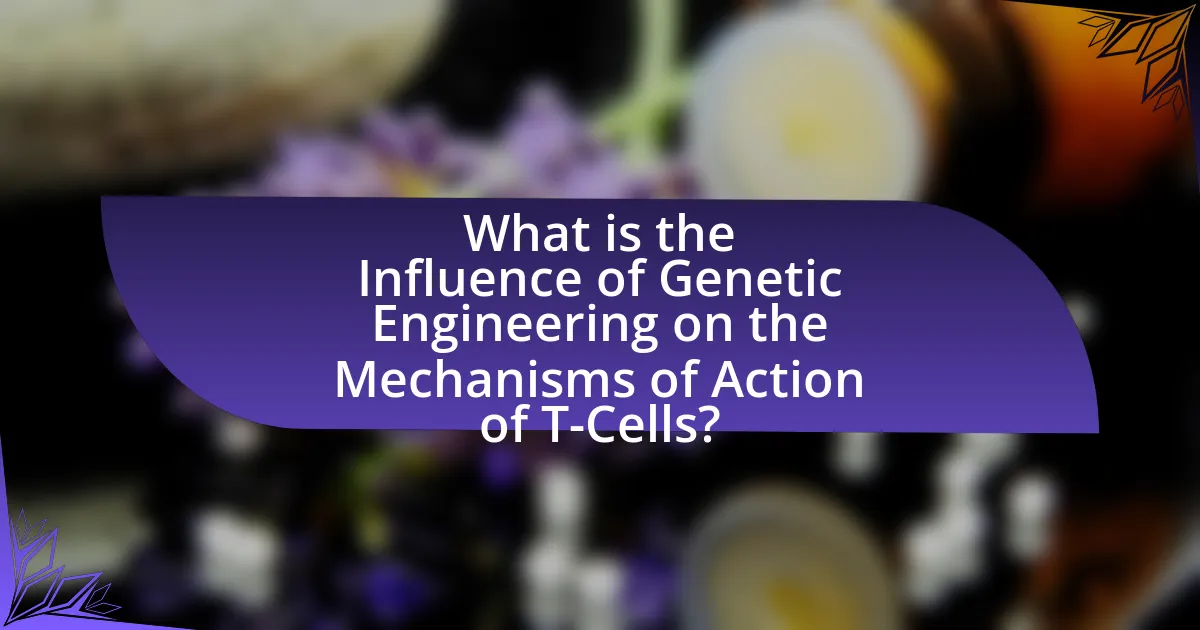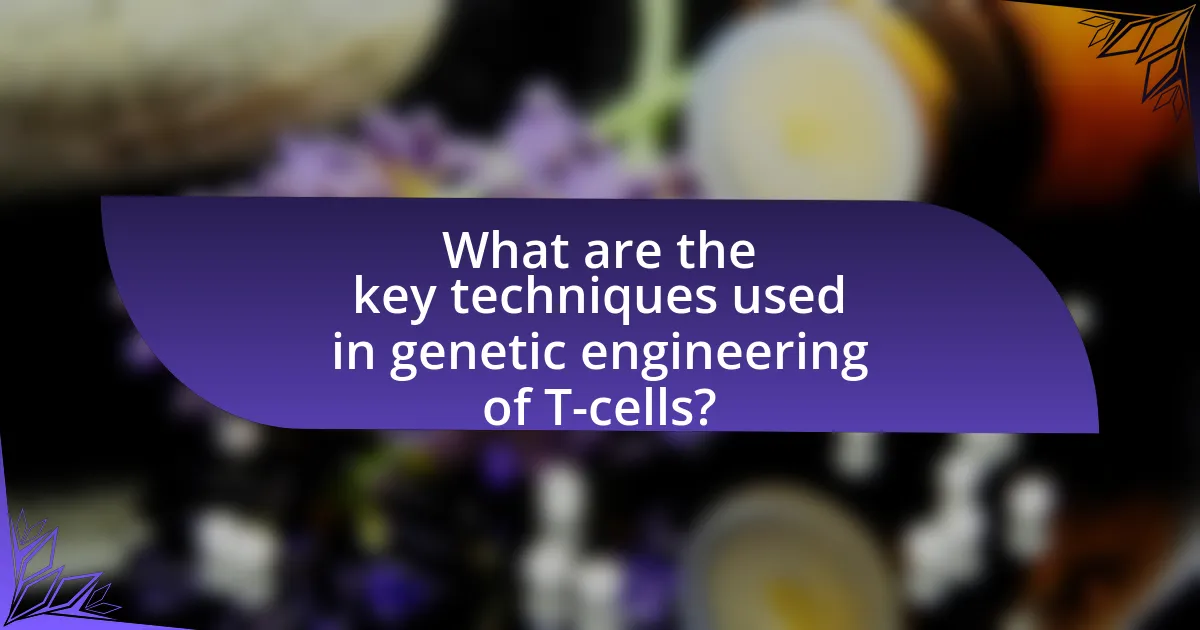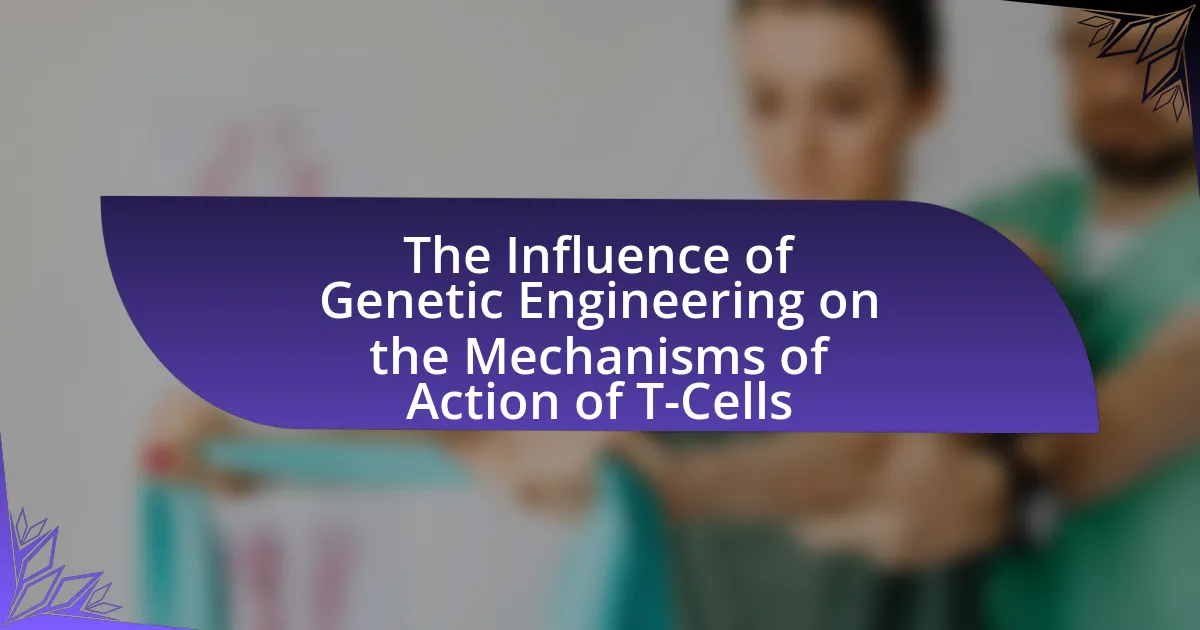The article focuses on the influence of genetic engineering on the mechanisms of action of T-cells, highlighting how precise modifications enhance their ability to recognize and attack cancer cells and pathogens. Key techniques such as chimeric antigen receptors (CARs) and CRISPR-Cas9 are discussed, illustrating their roles in improving T-cell functionality and therapeutic efficacy. The article also addresses the implications of these advancements in cancer therapy, infectious disease management, and the ethical considerations surrounding genetic modifications in T-cells. Overall, it emphasizes the transformative potential of genetic engineering in optimizing T-cell responses for various medical applications.

What is the Influence of Genetic Engineering on the Mechanisms of Action of T-Cells?
Genetic engineering significantly enhances the mechanisms of action of T-cells by enabling precise modifications to their genetic material, which can improve their ability to recognize and attack cancer cells or pathogens. For instance, the introduction of chimeric antigen receptors (CARs) into T-cells allows them to target specific antigens on tumor cells, leading to more effective immune responses. Research has shown that CAR T-cell therapies have resulted in substantial remission rates in certain types of blood cancers, demonstrating the practical impact of genetic modifications on T-cell functionality. Additionally, genetic engineering techniques such as CRISPR-Cas9 facilitate the knockout of inhibitory receptors on T-cells, further boosting their activity against tumors. These advancements illustrate the transformative role of genetic engineering in optimizing T-cell responses for therapeutic purposes.
How does genetic engineering modify T-cell functions?
Genetic engineering modifies T-cell functions by enabling precise alterations in their genetic makeup, which enhances their ability to recognize and attack specific pathogens or cancer cells. Techniques such as CRISPR-Cas9 allow for targeted gene editing, which can improve T-cell receptor specificity and increase their proliferation and persistence in the body. For instance, engineered T-cells can be designed to express chimeric antigen receptors (CARs), which significantly boost their effectiveness against tumors by allowing them to identify and bind to cancer-specific antigens. This approach has been validated in clinical settings, with CAR T-cell therapies demonstrating substantial success in treating certain types of leukemia and lymphoma, showcasing the transformative impact of genetic engineering on T-cell functionality.
What specific genetic modifications are commonly applied to T-cells?
Common genetic modifications applied to T-cells include the introduction of chimeric antigen receptors (CARs), the knockout of immune checkpoint genes, and the insertion of cytokine genes. CARs enable T-cells to recognize and attack specific cancer cells by engineering them to express receptors that bind to tumor antigens. The knockout of immune checkpoint genes, such as PD-1, enhances T-cell activation and proliferation by removing inhibitory signals. Additionally, the insertion of cytokine genes, like IL-2 or IL-15, can improve T-cell survival and function in the tumor microenvironment. These modifications have been validated through clinical trials, demonstrating their effectiveness in enhancing T-cell responses against various cancers.
How do these modifications enhance T-cell activity against pathogens?
Genetic modifications enhance T-cell activity against pathogens by increasing their specificity and efficacy in targeting infected cells. These modifications often involve the introduction of chimeric antigen receptors (CARs) or engineered T-cell receptors (TCRs), which allow T-cells to recognize and bind to specific antigens presented by pathogens. For instance, CAR T-cell therapy has shown significant success in treating certain cancers by enabling T-cells to effectively identify and eliminate malignant cells. Studies have demonstrated that engineered T-cells can exhibit improved proliferation, persistence, and cytotoxicity, leading to a more robust immune response against pathogens.
Why is understanding T-cell mechanisms important in immunology?
Understanding T-cell mechanisms is crucial in immunology because T-cells play a central role in the adaptive immune response, directly influencing the body’s ability to fight infections and diseases. T-cells are responsible for recognizing and responding to specific antigens, which is essential for developing effective vaccines and immunotherapies. For instance, research has shown that T-cell activation and differentiation are key processes in combating cancer, as evidenced by the success of CAR T-cell therapies that genetically modify T-cells to target tumor cells. This highlights the importance of understanding T-cell mechanisms to enhance therapeutic strategies and improve patient outcomes in various diseases.
What role do T-cells play in the immune response?
T-cells are crucial components of the adaptive immune response, primarily responsible for identifying and eliminating infected or cancerous cells. They achieve this through various mechanisms, including the activation of cytotoxic T-cells that directly kill infected cells and the activation of helper T-cells that enhance the immune response by stimulating B-cells and other immune cells. Research has shown that T-cells can recognize specific antigens presented by infected or abnormal cells, which is fundamental for targeted immune responses. For instance, studies indicate that the specificity of T-cell receptors allows for the precise targeting of pathogens, making T-cells essential for effective immunity.
How can genetic engineering improve T-cell responses in cancer therapy?
Genetic engineering can improve T-cell responses in cancer therapy by enhancing their ability to recognize and attack cancer cells. Techniques such as CAR (chimeric antigen receptor) T-cell therapy involve modifying T-cells to express receptors that specifically target tumor antigens, leading to increased specificity and efficacy in eliminating cancer cells. Studies have shown that CAR T-cell therapies have achieved significant remission rates in certain blood cancers, with a reported overall response rate of approximately 82% in patients with acute lymphoblastic leukemia. This demonstrates the potential of genetic engineering to fundamentally alter T-cell functionality, making them more effective in combating cancer.

What are the key techniques used in genetic engineering of T-cells?
The key techniques used in genetic engineering of T-cells include CRISPR-Cas9, viral vector transduction, and transposon-based systems. CRISPR-Cas9 allows for precise editing of T-cell genomes by creating double-strand breaks at specific locations, enabling targeted modifications. Viral vector transduction utilizes modified viruses to deliver genetic material into T-cells, facilitating the introduction of new genes or the knockout of existing ones. Transposon-based systems, such as Sleeping Beauty, enable stable integration of genetic constructs into T-cell genomes, enhancing their functionality. These techniques have been validated through numerous studies demonstrating their effectiveness in modifying T-cell responses for therapeutic applications, such as in cancer immunotherapy.
How does CRISPR technology impact T-cell engineering?
CRISPR technology significantly enhances T-cell engineering by enabling precise genetic modifications that improve T-cell functionality and specificity. This technology allows researchers to edit genes associated with T-cell activation, proliferation, and persistence, thereby optimizing their ability to target and eliminate cancer cells or infected cells. For instance, studies have demonstrated that CRISPR can be used to knock out immune checkpoint genes, such as PD-1, in T-cells, leading to enhanced anti-tumor responses in preclinical models. Additionally, CRISPR facilitates the introduction of chimeric antigen receptors (CARs) into T-cells, which can redirect their specificity towards specific tumor antigens, thereby increasing the efficacy of immunotherapies.
What are the advantages of using CRISPR for T-cell modifications?
The advantages of using CRISPR for T-cell modifications include precise gene editing, enhanced efficiency, and the ability to target multiple genes simultaneously. CRISPR technology allows for specific alterations in the T-cell genome, which can improve the effectiveness of T-cell therapies in treating diseases like cancer. Studies have shown that CRISPR can achieve high editing efficiency, with reported rates exceeding 50% in some cases, enabling rapid development of modified T-cells. Additionally, CRISPR’s multiplexing capability allows researchers to modify several genes at once, facilitating complex therapeutic strategies that can enhance T-cell function and persistence in the body.
What challenges are associated with CRISPR applications in T-cells?
CRISPR applications in T-cells face several challenges, including off-target effects, delivery mechanisms, and immune responses. Off-target effects occur when CRISPR inadvertently edits unintended genomic sites, potentially leading to harmful consequences. Studies have shown that while CRISPR is designed for precision, it can still cause mutations at sites other than the intended target, which raises safety concerns. Delivery mechanisms also pose a challenge, as effectively introducing CRISPR components into T-cells requires sophisticated techniques, such as viral vectors or electroporation, which can be inefficient or lead to cell damage. Additionally, the immune system may recognize CRISPR components as foreign, triggering an immune response that can reduce the efficacy of the treatment. These challenges highlight the need for ongoing research to enhance the safety and effectiveness of CRISPR technologies in T-cell applications.
What are the implications of viral vector systems in T-cell engineering?
Viral vector systems significantly enhance T-cell engineering by facilitating the precise delivery of genetic material into T-cells. These systems, such as lentiviruses and adenoviruses, enable the stable integration of therapeutic genes, which can improve T-cell functionality and persistence in vivo. For instance, lentiviral vectors have been successfully used in CAR T-cell therapies, leading to effective treatments for certain types of cancers, as demonstrated in clinical trials where patients exhibited durable responses. Additionally, viral vectors can be engineered to express multiple genes simultaneously, allowing for the co-expression of costimulatory molecules that further enhance T-cell activation and efficacy. This capability underscores the transformative role of viral vector systems in advancing T-cell therapies and improving patient outcomes.
How do viral vectors facilitate gene delivery in T-cells?
Viral vectors facilitate gene delivery in T-cells by utilizing their natural ability to infect host cells and introduce genetic material. These vectors, often derived from viruses like lentiviruses or adenoviruses, are engineered to carry specific genes into T-cells, allowing for the expression of therapeutic proteins or the modification of T-cell functions. For instance, lentiviral vectors can integrate the delivered gene into the T-cell genome, leading to stable expression and long-term effects, which is crucial for therapies such as CAR-T cell treatments. Studies have shown that the efficiency of gene transfer can reach up to 90% in T-cells using these viral vectors, demonstrating their effectiveness in genetic engineering applications.
What safety concerns arise from using viral vectors in T-cell therapies?
Safety concerns arising from using viral vectors in T-cell therapies include the potential for insertional mutagenesis, immune responses against the vector, and the risk of off-target effects. Insertional mutagenesis can lead to oncogenesis if the viral vector integrates into or near oncogenes, potentially causing cancer. Immune responses may result in the destruction of both the viral vector and the modified T-cells, reducing the therapy’s efficacy. Additionally, off-target effects can occur if the viral vector inadvertently alters non-target genes, leading to unintended consequences. These concerns are supported by studies indicating that insertional mutagenesis has been linked to cases of leukemia in patients treated with gene therapies utilizing viral vectors.

What are the potential applications of genetically engineered T-cells?
Genetically engineered T-cells have significant potential applications in cancer immunotherapy, autoimmune disease treatment, and infectious disease management. In cancer immunotherapy, engineered T-cells, such as CAR T-cells, are designed to target and destroy cancer cells, demonstrating efficacy in treating hematologic malignancies like acute lymphoblastic leukemia, as shown in clinical trials where over 80% of patients achieved remission. For autoimmune diseases, genetically modified T-cells can be tailored to suppress harmful immune responses, offering a novel approach to conditions like multiple sclerosis. Additionally, in infectious diseases, engineered T-cells can enhance the immune response against pathogens, exemplified by ongoing research into HIV and viral infections, where modified T-cells aim to improve viral control and patient outcomes.
How can genetically engineered T-cells be used in cancer treatment?
Genetically engineered T-cells can be used in cancer treatment by enhancing their ability to recognize and attack cancer cells. This is achieved through techniques such as CAR (Chimeric Antigen Receptor) T-cell therapy, where T-cells are modified to express receptors that specifically target antigens present on tumor cells. For instance, studies have shown that CAR T-cell therapies have led to significant remission rates in certain blood cancers, such as acute lymphoblastic leukemia, with over 80% of patients achieving complete remission in clinical trials. This demonstrates the effectiveness of genetically engineered T-cells in specifically targeting and eliminating cancer cells, thereby improving patient outcomes.
What types of cancers are most responsive to T-cell therapies?
Cancers that are most responsive to T-cell therapies include melanoma, certain types of leukemia, and lymphomas. Melanoma has shown significant responsiveness due to the presence of tumor-specific antigens that T-cells can target effectively. In the case of leukemia, particularly acute lymphoblastic leukemia (ALL), T-cell therapies like CAR T-cell therapy have demonstrated high remission rates, with studies indicating over 80% of patients achieving complete remission. Lymphomas, especially diffuse large B-cell lymphoma (DLBCL), also respond well to T-cell therapies, with clinical trials reporting substantial response rates. These cancers exhibit characteristics that make them suitable targets for T-cell-mediated immune responses, validating the effectiveness of T-cell therapies in these contexts.
How do engineered T-cells overcome tumor microenvironment challenges?
Engineered T-cells overcome tumor microenvironment challenges primarily through genetic modifications that enhance their persistence, functionality, and ability to recognize tumor antigens. These modifications often include the introduction of chimeric antigen receptors (CARs) that enable T-cells to target specific tumor markers, thereby improving their ability to infiltrate and attack tumor cells despite the immunosuppressive conditions typically present in the tumor microenvironment. Additionally, engineered T-cells can be modified to express cytokines or other factors that counteract the immunosuppressive signals, such as transforming growth factor-beta (TGF-β) and programmed cell death protein 1 (PD-1), which are often elevated in tumors. Studies have shown that CAR T-cell therapies can lead to significant tumor regression in certain cancers, demonstrating their effectiveness in overcoming these challenges.
What role do genetically engineered T-cells play in infectious disease management?
Genetically engineered T-cells play a crucial role in infectious disease management by enhancing the immune response against specific pathogens. These modified T-cells, often created through techniques like CAR-T cell therapy, are designed to recognize and attack infected cells more effectively than unmodified T-cells. For instance, in the treatment of viral infections such as HIV, genetically engineered T-cells can target and eliminate cells harboring the virus, thereby reducing viral load and improving patient outcomes. Studies have shown that these engineered cells can persist in the body and provide long-term protection against reinfection, demonstrating their potential in managing infectious diseases.
How can T-cell engineering enhance responses to viral infections?
T-cell engineering can enhance responses to viral infections by modifying T-cells to improve their specificity and efficacy against viral antigens. This process often involves techniques such as CRISPR-Cas9 gene editing, which allows for the precise alteration of T-cell receptors (TCRs) to recognize and target specific viral proteins more effectively. For instance, engineered T-cells can be designed to express high-affinity TCRs that bind more strongly to viral peptides presented by infected cells, leading to increased activation and proliferation of these T-cells in response to the infection. Studies have shown that such engineered T-cells can significantly reduce viral loads and improve survival rates in models of viral infections, demonstrating the potential of T-cell engineering in enhancing immune responses.
What are the prospects for T-cell therapies in combating emerging pathogens?
T-cell therapies hold significant prospects in combating emerging pathogens due to their ability to be genetically engineered for enhanced specificity and efficacy. These therapies can be tailored to recognize and attack specific antigens presented by pathogens, which is crucial in responding to novel infectious agents. For instance, recent advancements in CAR T-cell therapy have demonstrated success in targeting viral infections, such as HIV, by modifying T-cells to express receptors that specifically bind to viral antigens. This approach not only increases the precision of the immune response but also enhances the persistence of T-cells in the body, allowing for a more robust defense against emerging threats. Furthermore, studies have shown that engineered T-cells can be rapidly produced and deployed in response to outbreaks, exemplifying their potential as a frontline defense mechanism against newly identified pathogens.
What are the ethical considerations surrounding T-cell genetic engineering?
The ethical considerations surrounding T-cell genetic engineering include concerns about safety, consent, and potential long-term consequences. Safety issues arise from the risk of unintended genetic modifications that could lead to harmful effects, such as the development of malignancies or autoimmune disorders. Informed consent is crucial, particularly when genetic engineering is applied to human subjects, as individuals must fully understand the risks and benefits involved. Additionally, the potential for creating genetically modified organisms raises questions about ecological impacts and the moral implications of altering human genetics. These considerations are underscored by regulatory frameworks and ethical guidelines established by organizations such as the National Institutes of Health and the World Health Organization, which emphasize the need for thorough risk assessments and ethical oversight in genetic research.
How do regulatory frameworks address genetic modifications in T-cells?
Regulatory frameworks address genetic modifications in T-cells by establishing guidelines and requirements for safety, efficacy, and ethical considerations in research and clinical applications. In the United States, the Food and Drug Administration (FDA) oversees the regulation of genetically modified T-cells, particularly in the context of gene therapy and CAR-T cell therapies, requiring extensive preclinical and clinical data to demonstrate safety and effectiveness before approval. Additionally, the National Institutes of Health (NIH) provides oversight through its Recombinant DNA Advisory Committee (RAC), which reviews research proposals involving genetic modifications to ensure compliance with safety standards. These frameworks are designed to protect patients and ensure that genetic modifications do not pose undue risks, as evidenced by the rigorous review processes and post-market surveillance mandated by regulatory bodies.
What ethical dilemmas arise from the use of genetically modified T-cells in humans?
The use of genetically modified T-cells in humans raises several ethical dilemmas, primarily concerning safety, consent, and potential long-term consequences. Safety concerns include the risk of unintended effects, such as off-target mutations that could lead to harmful side effects or new diseases. Informed consent is another critical issue, as patients must fully understand the implications of undergoing genetic modification, which can be complex and difficult to communicate. Additionally, the potential for genetic modifications to be passed on to future generations raises questions about the long-term impact on human genetics and biodiversity. These ethical dilemmas are underscored by ongoing debates in bioethics and regulatory frameworks, highlighting the need for careful consideration and oversight in the application of genetic engineering technologies.
What best practices should be followed in T-cell genetic engineering?
Best practices in T-cell genetic engineering include ensuring precise gene editing, validating the functionality of engineered T-cells, and adhering to ethical guidelines. Precise gene editing, often achieved through technologies like CRISPR-Cas9, minimizes off-target effects and enhances the specificity of modifications. Validation of T-cell functionality involves rigorous testing to confirm that engineered cells exhibit desired characteristics, such as enhanced proliferation or cytotoxicity against target cells. Adhering to ethical guidelines ensures compliance with regulatory standards and promotes responsible research practices, which is crucial given the potential implications of genetic modifications in human therapies.



